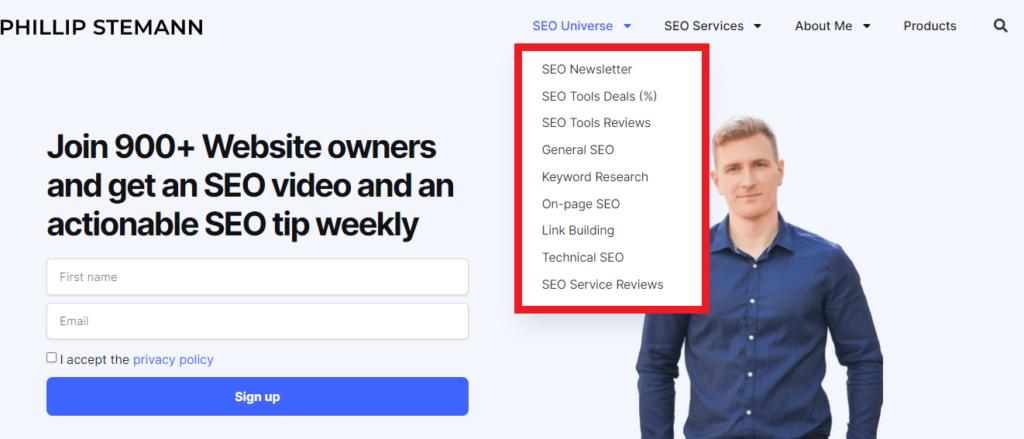Are you struggling to get traffic to your website despite creating high-quality content? Every content creator, including myself, has been frustrated by this at one time or another.
The problem is that search engines like Google prioritize content from people that they deem to have expertise, authoritativeness, and trustworthiness (EAT.)
It makes sense that they only want to show content from people who know what they are talking about. So, how can you show Google that you are knowledgeable in a certain field?
You need to create an SEO topical map.
A topical map will help you to cover the topics you are trying to address in extreme detail, which will show Google that you are an expert in the field.
Let’s dive into exactly how you can create an SEO topical map, and how you can use it to improve your search engine visibility.
What is an SEO Topical Map?
A topical map is a way that you can visualize topics and subtopics that are relevant to your website niche or content.
It can act like a roadmap to help you develop a content strategy that will cover topics comprehensively. Think of it as a blueprint that helps you figure out the relevant content you need to create and bring in organic traffic.
Why Do You Need a Topical Map?
There are several reasons why you might want to use this strategic approach to content planning.
- Organized Content: It helps you organize your content around specific themes or topics, making it easier for both users and search engine crawlers to navigate your site and find relevant information.
- SEO Strategy: Search engines like Google increasingly prioritize websites that demonstrate topical authority. A topical map helps you establish and showcase your expertise by covering all relevant topics comprehensively.
- User Experience: A well-structured topical map enhances the user experience by providing clear navigation through categories or internal links and helping users find the information they need quickly and easily.
By having better-defined relationships between topics and increased topical authority, you not only improve your search engine rankings, leading to more traffic but also encourage users to stay on your website for longer, decreasing your bounce rate.
How to Build a Topical Map
Creating a comprehensive topical map can be quite time-consuming, but it is a relatively simple process.
Let’s start by looking at the basics as if it is your first time creating content on your website. We’ll cover the process in a step-by-step guide.
Even if you have an existing website with a great deal of content, you should start with a basic topic map, too.
This will allow you to identify any gaps in your existing content that you might have missed otherwise and give you an idea of how you can better organize your existing content.
Start With a Broad Topic
The first step is identifying a broad topic or theme. In my experience, this often doesn’t require too much thought. It should be easy to tell what your website is about.
For example, if you are a personal trainer, the core topic for your website might be ‘fitness.’
Look at my website. The central topic is ‘SEO.’
You really don’t have to be more specific. Just make sure that you have a good idea of your niche and can narrow it down to a single keyword.
Analyze Topics and Sub-Topics
Now, you need to start getting more specific. Break your topic down into smaller sub-topics.
These will be your major categories. You can see these on my website in the drop-down menu above. SEO has been divided into link building, technical SEO, on-page SEO, etc.

Looking at the example from above, if you are a personal trainer, you might split fitness into sub-topics like ‘strength training,’ ‘nutrition,’ and so on.
It helps to write this down to keep track of your topical hierarchy under your central theme.
I highly recommend breaking these topics up at least once more into another set of subtopics.
This second set of sub-topics might not be seen by anyone in drop-down menus or any other physical form on your website but will act as further guidance for you.
For the fitness website, this might look like the strength training category being split into ‘form and technique,’ ‘workout routines,’ and more.
Plan Your Content Strategy
Once you have organized all of your topics and subtopics in a logical structure so that you can clearly see the topical hierarchy, you can start creating your content strategy.
Look for keywords under each topic. Look at the search volume and competition of each keyword so that you can understand the likelihood of a piece of content ranking.
Then, figure out what kind of content will work best for each keyword. Understand user intent and think about whether a blog post, video, or other piece of content will work better.
Connect Sub-topics to Pillar Pages Through Internal Linking
You need to create pillar content and pages. This pillar content refers to content that provides comprehensive coverage of a topic, like an ultimate guide.
You would include internal links in this pillar content that would link to the topics that fall under its umbrella.
Pillar content helps search engines, in particular, to understand the hierarchy of your content. This will help improve your SEO performance.
Additionally, it can provide valuable insights to users who may want to explore a topic further and will help improve user engagement metrics.
Review and Update Your Topical Map Regularly
Once you’ve got your pillar content, your work is not done. You then need to continuously review your topic map and content relevance to make sure that you keep up with changing industry trends.
Topical mapping is a continuous process in the ever-changing digital landscape.
Advanced Tools and Techniques
Now that we’ve covered the basics of topical mapping, you should be able to start creating a mind map with your list of topics.
However, there are many online tools out there that can help you identify relevant keywords.
Let’s look at some of these tools and how you might be able to use them.
Analyzing Google Knowledge Graphs
Google Knowledge Graphs are little boxes of information that pop up when you search for certain things. By analyzing these panels, you can uncover valuable insights into the subtopics and related user queries.
In my experience, you can get a lot of information if you pay attention to the “People also search for” and “Related topics” sections to discover new subtopics and keyword ideas to include in your topical map.

Utilizing Google Trends Related Topics Report
Google Trends offers a treasure trove of data on search trends.
Specifically, it has a Related Topics report that you can use to build topical clusters and find content gaps. This can help you expand your topical map to cover trending subjects and current content and stay ahead of the curve in your content strategy.
Extracting Sub-topics from Query Analysis
Dig deep into search query analysis to uncover hidden subtopics and user intents. Tools like Google Search Console and other keyword research tools can provide valuable data.
I’ve written an entire article on how you can use Google Search Console for SEO.
Use this information to figure out what people are looking for when they come across your site. User search intent is very important, so figure out if you are answering their questions or if you need to add additional content.
Planning Content with Keyword Research
Keyword research isn’t just about finding high search volume keywords; it’s also a powerful tool for building topical authority.
Use keyword research tools like Ahrefs, Semrush, or LowFruits to identify relevant keywords and phrases related to your main topics.

Although these keywords might be too similar to create whole new content pieces without risking keyword cannibalization or duplicate content, you can include them in your existing content to improve your ranking potential.
Just be careful to avoid keyword stuffing and make sure that you are always producing high-quality content as part of a holistic SEO approach.
Creating Semantic Clusters with Related Keywords Report
Semantic clustering involves grouping related keywords and phrases into clusters based on their semantic similarity.
Tools like SEMrush’s Related Keywords report can help you create a list of keyword clusters.
By grouping related keywords together, you can create content that addresses multiple aspects of a topic and improves both topical relevance and topical authority.
Competitive Analysis
Understanding what your competitors are doing can help you if you get stuck building your topic clusters. Aside from keyword suggestions, it is always a good idea to keep up to date on others’ approaches to content creation.
Remember that you and your competitors are always trying to improve your search engine visibility to rank above one another. This can be frustrating, but if you notice that there are certain topic structures that work for them, they will likely work for you.
Additionally, you can figure out if there are any gaps in their content. By doing this, you can get to the content first, benefiting from the traffic before there is competition.
First, you need to identify your competitors. You can do this by typing in the main keywords that you are hoping to cover on your website. The most authoritative sites will usually show up first.
Then, you can start analyzing the way that they have structured their website to split that broader topic into subtopics. You will really need to do this manually, but it should not take too long if you have already done the groundwork on your side.
Once you have done that, you can use SEO tools to analyze your competitors’ performance in search results. Look at factors like keyword rankings, organic traffic, and backlink profiles to assess their SEO strength.
Then, you will need to experiment. You might be able to see what your competitors are doing well right away, like if they have missed topics. However, things like the connections between topics may not always be obvious.
If you see something you think will improve your own site, try it out.
Implementing Your Topical Map
Now that you’ve developed your topical map, it’s time to put it into action. Exactly how you do this will depend on whether you are starting a new website or working with an existing one, but the basic principles remain the same.
First, you need to start creating content based on your topical map. Use the subtopics and keywords you’ve identified to guide your content creation process.
If you already have a website, you need to figure out what you can tick off of your topical mindmap first. I highly recommend then creating content that will help cement your authority on a topic. So, start with topics you have almost ‘finished.’
If you are starting from scratch, you may find it easiest to start with your pillar content. Just be aware that it might not rank well initially due to high competition levels. Then, you can create content for your less competitive, long-tail keywords.
As you create your content, make sure that you optimize your on-page elements, including titles, headings, meta descriptions, and alt tags, to align with your topical map.
Remember that, in order to increase your visibility in search results, you need to cover all of the basics of SEO that you would have covered anyway. This will ensure that search algorithms understand what your content is about.
Once you have a fair amount of content, you can start linking internally. Adding logical internal links is one of the most crucial elements for improving website navigation.
And then, of course, track your results. Look at key metrics like organic traffic, keyword rankings, and engagement metrics to identify areas for improvement.
Join 900+ to receive a weekly SEO video from my YouTube channel, which I’ll share, and an actionable SEO tip every week.
Wrap-Up
By following the steps outlined in this guide, you will be able to use the tools and techniques needed to organize your content into topic clusters, target relevant keywords, and provide valuable information to your audience.
Remember, building a topical map is an ongoing process. Continuously review and update your content hierarchy to adapt to changes in your industry, user preferences, and search engine algorithms.
I highly recommend checking out SEO newsletters and podcasts to help you keep up to date with industry changes and improve your domain authority.
FAQ
What is a topical map for SEO?
A topical map for SEO is a way to visualize topics and subtopics that are relevant to your website. This helps you strategize your content creation to increase your online visibility.
Which sitemap is best for SEO?
The best sitemap for SEO is an XML sitemap. This is because it helps search engines crawl and index your website the most efficiently by providing additional information.
How do you start creating a topical map effectively?
To start creating a topical map effectively, you should identify a broad topic that is relevant to you, then move on to analyzing subtopics, which you can connect to pillar pages.
What is the difference between a sitemap and a heat map?
The difference between a sitemap and a heat map is that a sitemap is a visual representation of your website’s structure that outlines hierarchy, and a heatmap is more graphical, depicting data using colors.


